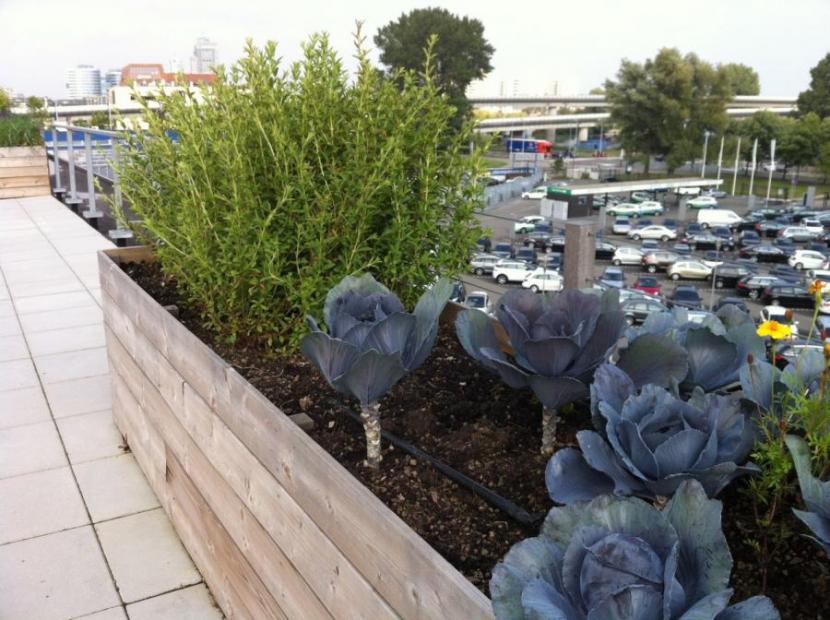URBAN FARMING & BUREAUS: ‘Zuidpark’ in Amsterdam –
The largest vegetable roof of Europe – the results of one year experience
Helga Fassbinder







Urban farming is in! In addition to tomatoes and lettuce on balconies and rooftops, there are also successful initiatives or groups of residents who grow vegetables, herbs and lettuces in many open spaces in the city. The vast rooftops in industrial areas were, until recently, a horticultural waste land.
However, a year ago a proactive investor, Jan Huijbrechts decided to create a vegetable garden on what was once an administration building in an industrial area in Amsterdam. It covers an area of 3,000 m2 for this urban farm at a height of 10 m. The building is surrounded by office buildings, commercial buildings, parking lots, freeways and highways. At the moment it is the largest urban farmed roof in Europe. A bold plan indeed simply because the existing urban farming projects were built and maintained by residents with a passion for gardening. To inspire office employees to do the same was well worth it.

On the roof there are two long wooden tables of 20 m with 40 m benches. Nice for lunch and coffee breaks or for an undisturbed thought in the fresh air while gazing at the wide horizon. There is wifi, you can hold meetings or even book for parties. In the building more than 1,000 employees are working for a variety of companies.
200,000 liters of topsoil has been used to fill half-height plant boxes/crates. These boxes/crates were placed after researching the structural integrity i.e. carrying capacity, allowed for each respective location. A light weight substrate consisting of a mixture of soil with high biological nutrients and peck roof substrate (ZinCo) was chosen. Above the actual roofing material which covers a rain runoff system is mounted (Smartex), which consists of an anti-rooting cloth onto which a grid of sensors was mounted with an aperture size of 3 mm, covered by a membrane of carbon which in case of leakage provides a quick distribution of water. In such cases the damp makes contact with wires that will cause a short circuit with the underlying sensor which allows one to find the exact location of the leak via a monitor. The last cover consists of concrete tiles on which the plant troughs are placed. These are watered by an electronically controlled irrigation system. More than 60 different varieties of plants have been grown organically. The combination of plants/veggies takes into account the seasons: there are always flowering plants, and there is always something ripe. Annuals are mixed with perennials.
To summarize, the vegetables growing on the roof of ‘ Zuidpark ‘ is a success.
On one hand there now exists the positive effects on the environmental conditions mentioned: In what was once a rooftop desert there are now plants – even if only on parts of the roof – supporting humidification and retention of rain water. There are also the positive effects of urban farming ascreating urban food production close to home, thus avoiding long transport distances and fresh fruits and vegetables can come straight to the table. Organic production also makes the employees aware of a sustainable and ecological basis of everyday life. On the other hand one must mention the social and economic impact: The vegetables roof has given the office block Zuidpark to a “name.”. It has contributed positively to the quality of working conditions of the emplyees and it is supporting the communication between employees and between enterprises based there. Result: full rental in a situation of extended vacancy in the bureau property sector. An example worth following!
Location: Zuidpark, Spaklerweg 52, Amsterdam
Owner: Zuidpark, Spaklerweg 52, Amsterdam
Design and renovation: Archicom, Eindhoven
Design of the vegetable roof: Biet & Boon, Amsterdam
Completion: June 2012
Bildquellen: Helga Fassbinder
